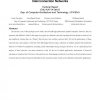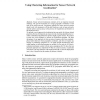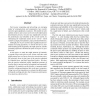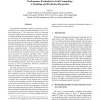1390 search results - page 131 / 278 » Coordination Patterns for Parallel Computing |
PC
2010
13 years 7 months ago
2010
The fat-tree is one of the topologies most widely used to build high-performance parallel computers. However, they are expensive and difficult to build. In this paper we propose t...
IPPS
1999
IEEE
14 years 1 months ago
1999
IEEE
A structured approach to parallel programming allows to construct applications by composing skeletons, i.e., recurring patterns of task- and data-parallelism. First academic and co...
DCOSS
2005
Springer
14 years 2 months ago
2005
Springer
Sensor network localization continues to be an important research challenge. The goal of localization is to assign geographic coordinates to each node in the sensor network. Locali...
CCGRID
2002
IEEE
14 years 2 months ago
2002
IEEE
Peer-to-peer computing and networking, an emerging model of communication and computation, has recently started to gain significant acceptance. This model not only enables client...
CCGRID
2007
IEEE
14 years 3 months ago
2007
IEEE
Experimental performance studies on computer systems, including Grids, require deep understandings on their workload characteristics. The need arises from two important and closel...




